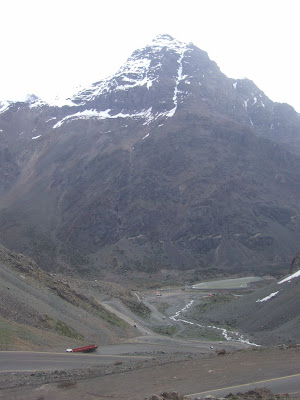Mendoza was our final stop before heading back to Chile. The city is quite lovely with lots of tree lined boulevards, canals carrying snowmelt from the Andes, and many outdoor cafes. With our travel expenses now well past our initial budget, and not having any Bahaí or couch-surfing buddies, we stayed in a cheap hostel inappropriately called Hostel Embajador (´Ambassador´ hostel) for three nights. We managed to join the small local group of Baha´is for their monthly community meeting (19 day Feast of Power), and met Ivana from Slovakia who had previously lived in Perth and knew Dan´s brother Sam quite well.
Our second day was spent wandering around the city, including spending a long while in the great playground in the central square. Most of the parks in Argentine cities have small kids playgrounds with loads of swings, roundabouts, jungle gyms, slides, see-saws, etc, all made from metal and painted bright colours. Quite different from the hyper-risk-averse playgrounds of Australia. Hero of course just loves them.
Our second day was spent wandering around the city, including spending a long while in the great playground in the central square. Most of the parks in Argentine cities have small kids playgrounds with loads of swings, roundabouts, jungle gyms, slides, see-saws, etc, all made from metal and painted bright colours. Quite different from the hyper-risk-averse playgrounds of Australia. Hero of course just loves them.
We ended up booking a full day tour of the ´high´ mountains (though not with the amusingly named tour company that Delia is showing off above). We felt we wanted to get a good taste of the Andes mountains, and it was comparable in cost to hiring a car. The tour started at 7:30 in the morning when we were picked up by Mariano, our jovial tour guide, and the driver, who barely said a word all day. Mariano, who explained that is nickname is Cabernet, after one of the common wines made in the area, and because he is quite reddish himself and also likes to imbibe, spoke a very rapid spanish, but we were proud to say we followed most of it. And even could make out the differences in accent from the platenese castillano spoken in Buenos Aires and there abouts. The tour took us from 800m in Mendoza to over 3000m up in the heart of the Andes near to the border with Chile.
We first passed through the Precordillera, the oldest mountains formed by the collision of the Nasca plate and the South American plate. These rugged hills are very dry and ancient and not high enough to have snow all year round. The next range of mountains as we head east is the Frontal Cordillera and is much younger and a lot higher. The Main Cordillera, which runs along the border with Chile is spectacular and includes Aconcagua, the 2nd highest mountain outside of Asia (6962m elevation).
Heading into the Frontal Cordillera followng the Mendoza River upstream. The amazing ´trans-andine´ railway line runs along the valley through some pretty hair-raising infrastructure. It has fallen into disrepair, but is apparently soon to be returned to use. Highly recommended if you ever come this way!
One of the tour stops was to visit a replica of an old bridge used by General San Martin in 1817 to cross over into Chile and help the local yokals rebel against colonical Spanish rule. Hero wanted to have a dip in the river, and was tickled pink by how cold the water was through her little 2.99 year old toes.






No it´s not the Himalayas, but a meditation centre in the Andes!

Early imaginative European explorers thought the little darker columns of rock were like monks going up into a cathedral, so called his mountain "Los Penitentes" (the penitants). The nearby ski resort has the same name.

Climbing up to one of the historic "refugios" or huts constructed along the "Ruta Sanmartiniano", a historic track used by the first European colonists and made famous by the aforementioned `liberator` of Argentina and Chile (from Spanish rule), Mr General San Martin.
On the way home to Mendoza, we stopped at the bridge of the Incas (Puente del Inca) situated about 2700 m above sea level. This ís an entirely natural arch that spans about 30 m over a tributary of the Mendoza river. It is thought to have been formed by a combination of avalanches during the ice ages and the precipitation of minerals contained in hot springs that seep through the area. The springs were used earlier in the 20th century as a health spa built in to the side of the bridge as part of an exclusive hotel. They continue to be used by enterprising locals who leave all sorts of objects (including old shoes) in the springs and then pick them up a few weeks later once they are petrified to sell to tourists!
We stopped for lunch and had our family favourite - sardines and heaps of mayo on bread buns!
Then on the Friday 6th Nov, we made the 6 hour bus ride across into Chile. Turned out to be a bit longer as the border crossing took about 2.5 hours and then on the way down to connect with the main north-south Chileno hwy, only one road lane was open. The close up of the pasty here is a Argentinian empanada (smaller and in Dan´s opinion much better than its typical Chileno counterpart), lovingly consumed by Dan (who was equal first in public voting on the "Olam most likely to enjoy empanadas"). Delia has an aversion to them (well done voters - she got ´0´votes). Check out how green the Chile side of the mountain is.









































No comments:
Post a Comment